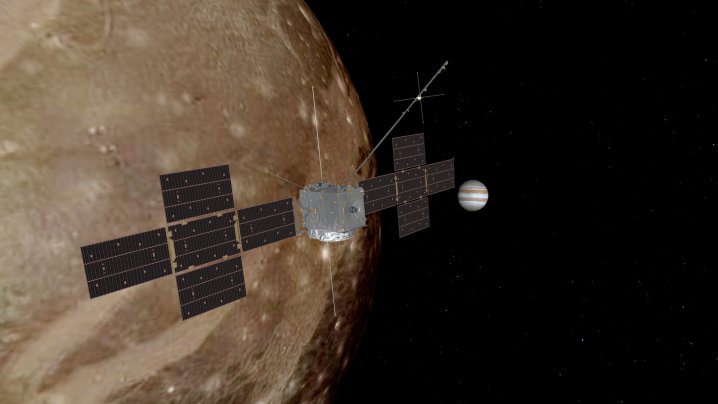Tomorrow will see the launch of the JUICE spacecraft, which will travel to the Jupiter system to investigate several of the moons there. The Jupiter Icy Moons Explorer, from the European Space Agency (ESA), will investigate three of Jupiter’s biggest moons, Europa, Ganymede, and Callisto, and will discover whether these distant, icy worlds could be habitable.
These moons could be potentially habitable even though they are very far from the sun as they are thought to host oceans of liquid water beneath thick, icy crusts. Evidence from previous missions which visited or passed by the Jupiter system has shown what appear to be plumes of water erupting from the surface of Europa, giving strong evidence that there may be a whole watery world beneath 10 to 15 miles of ice.

The launch of the spacecraft is scheduled for Thursday, April 13, using an Ariane 5 rocket from Europe’s Spaceport in Kourou, French Guiana (and you can watch the launch from home). To prepare for the launch the spacecraft was fully integrated last year, and was then packed up and shipped from its testing location in Toulouse, France to French Guiana.
JUICE folds up to a small size of around 4 by 4 by 2 meters for launch, so that it can fit in the rocket, then it will deploy to its full size of 17 by 27 by 14 meters once in orbit.
That deployment includes folding out the spacecraft’s large solar panels, which need to be big to capture the faint rays of the sun for power as it travels far out into the solar system toward Jupiter, and a variety of antennae and booms that will hold instruments. These booms are needed to hold the instruments away from the spacecraft’s body so that they can take sensitive readings of factors like magnetic fields without interference from the spacecraft’s systems.
The main focus of the JUICE mission will be Ganymede, which the spacecraft will fly past 12 times, coming within 250 miles of the moon at its closest approach. Ganymede is unusual in that it is the only moon in the solar system which is known to generate its own magnetic field, and this magnetic field sits within the larger magnetic field of the planet Jupiter and interacts with it in complex ways. Ganymede’s magnetic field also creates auroras, or bands of glowing gas around the moon, which are affected by the magnetic field of Jupiter too.
JUICE will take measurements from Ganymede to learn about its gravity, shape, and internal structure, as well as its magnetic field, to build up a picture of how it interacts with the larger Jupiter system. It will also look for biosignatures, of elements that are required for life such as carbon, oxygen, iron, and water.
The mission will also perform two flybys of the Europa moon, looking for more biosignatures and indications of water in particular, and 21 flybys of Callisto, which could hold clues to how Jupiter looked when it was young.



